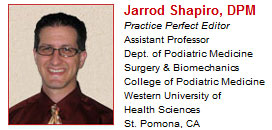|
After that, other expectations include: leaving and arriving on time, being treated courteously, having my bag arrive to the same location as me, a clean airplane, etc.
If physicians can realize this ego-bruising fact, we will understand it is incumbent upon us to prove to our patients why they should see us. We must provide an experience that goes beyond the baseline for the profession, one that exceeds their expectations.
For a medical office visit, many of the same baseline service characteristics exist. Our patients want to be cured of their ailment (our alternative to arriving alive) or at least have it improved. If you fail to improve their medical issue, they’ll find someone else. They also expect to be seen on time and to be treated in a clean office by a pleasant staff. If that’s what your office provides, then congratulations, you’re treating your patients at the most basic level of service.
|
FEATURED LECTURE
|
|
Today's Featured Lecture "Complex Limb Salvage: A New Perspective on Grafting" by David Pougatsh, DPM appears at the conclusion of the article.
|
How does the medical provider go beyond the baseline and provide superior service? Do what my airline has consistently failed to do: go beyond the baseline. Be thoughtful about what your patrons desire and then provide service beyond that.
First, don’t annoy me. From the minute I arrived at the check-in counter, I was frustrated by the multiple redundant steps I had to experience. When I booked the tickets through the University’s travel agent, I was not able to request a seat assignment. Then, when I checked in, I was again not allowed to get my seat assignment (I was told I would receive it at the gate). I was also told this would be the case for my connecting flight. When finally at the gate, I had to wait again for my seat. By the time I was finally granted an assignment, there were few choices left. During this entire time, I was treated with a cold formality without any semblance of friendliness or understanding. Needless to say this was annoying.
Our patients are often the receivers of various annoyances at the office. Having to wait excessively is annoying. Showing up for an appointment expecting treatment only to be rescheduled due to lack of insurance authorization is incredibly annoying. Being treated coldly by front staff goes beyond annoying. This is the reason why front office staff is as important – and probably more important – than the doctor.
I’ll admit to an annoyance that bothers me about my own office. When my current clinic was built (a very expensive building with an aim toward interprofessional care with a teaching role), no one considered what a podiatric office would require, such as a grinder. Because the office has no ventilation for a podiatric grinder – it’s an OSHA violation to use one without venting, apparently – I am not able to make modifications to my patients’ orthoses without sending them back to the lab. Having to return orthoses is a major inconvenience that delays treatment and lowers quality of care. Most of my patients are gracious about the delay, but this is clearly an annoyance that reduces service quality.
How can a physician set up an office to provide superior service?
Here are three suggestions:
- Analyze your office policies and procedures for redundancies and potential service breaks. Work to eliminate them. For example, create a method to review all incoming referrals and attempt to obtain necessary preauthorizations when possible.
- Educate and empower your staff to participate in the office review process. No one understands how your office functions – and what its limitations are – better than your staff.
- Perform a patient survey. I know it is scary, but you should ask your patients about their desires and what would make their experience at your practice even better than it is. Most importantly, survey as many patients as possible that are no longer with the practice.
There are many other options to improving practice service quality. No one has a perfect airline or a perfect medical practice. However, with an open mind, a willingness to address our deficiencies, and an attention to detail we can improve – all for our patients’ benefit.
###
|




























 This activity has been planned and implemented in accordance with the standards and requirements for approval of providers of continuing education in podiatric medicine through a joint provider agreement between the Kent State University College of Podiatric Medicine and PRESENT e-Learning Systems.
This activity has been planned and implemented in accordance with the standards and requirements for approval of providers of continuing education in podiatric medicine through a joint provider agreement between the Kent State University College of Podiatric Medicine and PRESENT e-Learning Systems. Physicians: Professional Education Services Group (PESG) is accredited by the Accreditation Council for Continuing Medical Education to provide continuing medical education for physicians.
Physicians: Professional Education Services Group (PESG) is accredited by the Accreditation Council for Continuing Medical Education to provide continuing medical education for physicians.